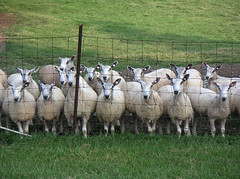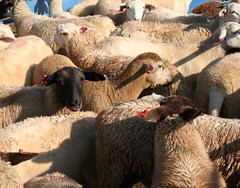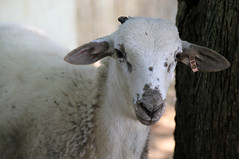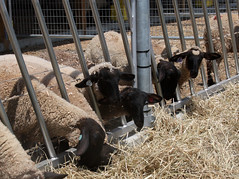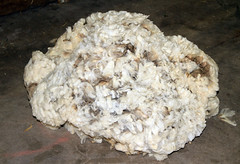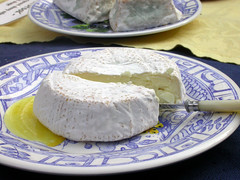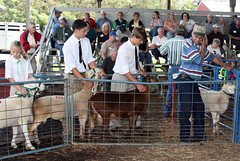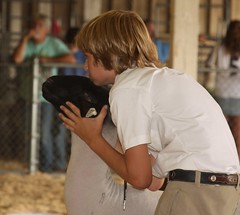- Sheep 201 Index
- Other web sites

Texas feedlot
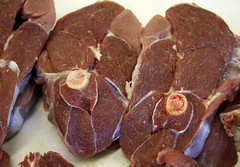
Center cut leg chops
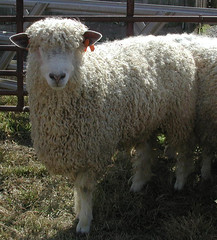
Wool-type ram

Sheep dairy

Flock for producing club lambs

Sheep grazing larkspur
Photo Source:
ARS Image Gallery
Meat, milk, or wool?
Sheep are multi-purpose animals, raised for their meat, milk, wool, and skins. While they have been used to control unwanted vegetation for centuries, grazing as a fee-based service is a relatively new opportunity for US sheep producers. Sheep are also a popular research model and some producers have developed businesses supplying animals or other products (e.g. blood) to bio-science.
One of the first and most important decisions a shepherd must make is to decide which aspect(s) of sheep production to focus on. While most sheep breeds are multi-purpose, most are best suited to either meat, milk, or wool production -- seldom all three. Production and marketing practices usually vary according to the purpose of the flock.
Meat Sheep
In the United States, most sheep and lambs are meat-type animals kept primarily for the production of lambs for meat or dual-purpose breeds kept for both meat and wool production. Meat production is also a significant profit center in sheep dairying.Meat sheep producers sell either slaughter lambs or feeder lambs. Slaughter lambs are usually purchased for immediate slaughter. In the United States, the average slaughter weight for a lamb processed in a federally-inspected plant is about 136 lbs. Lambs sold into ethnic markets tend to be much lighter, usually less than 100 lbs. and often less than 80 lbs. Increasingly, there is a market for slaughter lambs of any weight.
Feeder lambs are lambs that are usually fed or grazed to heavier weights before being harvested. Feeder lambs vary in weight, usually from 50 to 100 lbs., with the demand usually being the highest for 60 to 90 lb. lambs. Increasingly, lamb feeders are having to compete with the ethnic markets for these light weight lambs.
In a meat sheep enterprise, the primary factors which determine profitability are percent lamb crop, lamb growth rates, and market prices. Unless forage resources are abundant or feed costs are very low, it is difficult to make a profit from a ewe that weans only one lamb, especially in areas where predation is high.
Lamb Feeding
Commercial lamb feeding is a traditional sheep enterprise in the US and is becoming more popular in other countries. In some parts of the US, lamb feeding is a seasonal enterprise, occurring primarily in the fall and winter, after pastures have stopped growing and crop residues are available for grazing. In other areas (e.g. Texas, Colorado, and the Corn Belt), lamb feed lots operate year-round. Many farmers feed their own lambs out.In a lamb feeding enterprise, feeder lambs (50 to 100 lbs.) are purchased and fed to finish weights of 100 lbs. or more. Besides the purchase price of the lambs, the major cost of finishing lambs is obviously feed. Lambs can be finished on a variety of diets: complete pelleted rations, whole grain rations, or high-forage diets. Cheap gains can often be put on lambs on pasture or crop aftermaths. Lambs can also be finished on various by-products feeds. Distiller's grains and other co-products have been used to feed out lambs.
Hair Sheep
The declining value of wool relative to meat, along with the decreasing number of sheep shearers, has contributed to the expansion of hair sheep, not only in the United States, but other countries as well. It is estimated that approximately 10 percent of the world's sheep population is hair sheep. According to a 2011 NAHMS study, 21.5 percent of sheep operations in the U.S. raised hair sheep breeds. Over 90 percent of the lambs that are marketed through the sale barn in San Angelo, Texas are now hair sheep.Hair sheep naturally shed their coats (mixtures of hair and wool fibers) and typically do not require shearing, crutching, or tail docking. Hair sheep (of tropical origin) tend to be more resistant to internal parasites (gastro-intestinal worms) and other pests than wooled sheep. In addition, hair sheep breeds possess many desirable reproductive characteristics, such as early puberty, out-of-season breeding, and prolificacy.
Hair sheep are usually promoted as an "easy-care" alternative to wooled sheep and traditional high-cost production systems. Hair sheep ewes are often lambed on pasture. Lambs are commonly grass-finished. Hair sheep lambs are usually better suited to the ethnic markets than the commodity markets, which tend to prefer heavy with more finish (fat cover). At the same time, hair sheep will also work in more intensive production systems.
Because hair sheep production continues to grow, there may be a good market for hair sheep breeding stock. Many hair sheep producers sell their ewe lambs as breeding stock and their male lambs for meat.
Wool Production
Wool was the first commodity to be traded internationally and is the product the public most commonly associates with sheep. However, the importance of wool (as a product) relative to meat has declined dramatically. In the early 1900's, the majority of income from a sheep enterprise was from the sale of wool. Today, it is the other way around. While wool is still important on many sheep farms, lambs almost always contribute the majority of income to the sheep farm. Fine wool brings the most money in the commodity market.Selling wool in the commercial wool market has limited profit potential for most producers, but the niche marketing of wool can pay big dividends. For example, while wool sold commercially may bring only 50 cents per pound, fleeces sold to hand spinners could bring as much as $15-$20 per pound. Many producers have their wool processed into yarn, roving, blankets, or crafts and market value-added products. There are several cooperative ventures in the US that will add value to a producer's clip.
Fleeces sold to hand spinners need to be of high quality. Feeding, housing, health care, handling, and harvesting are all critical to the production of high quality wool. It goes without saying that fleeces should be skirted. Skirting is when the undesirable parts of the fleece are removed: belly wool, top knots, leg clippings, tags, stained wool, cotted wool, and short wool.
Some producers put covers on their sheep to prevent the fleeces from getting dirty and guard against the sun's ultraviolet rays, which may cause fading at the tips of colored fleeces. Since wool grows more under covers, covers have to be changed repeatedly as the fleece grows.The marketing of fine wools is also becoming more of a niche market, as farmers and ranchers are finding ways to add value to their wool clips.
Sheep Dairying
Sheep have been milked for thousands of years and were milked long before the first cow was milked. The world's commercial dairy sheep industry is concentrated in Europe and the countries on or near the Mediterranean Sea. The dairy sheep industry is very small in the United States. Most sheep dairies are located in the Upper Midwest (Wisconsin and Minnesota), California, and the New England states.Sheep's milk is usually made into gourmet cheeses. Some milk is made into yogurt and ice cream. Fresh sheep's milk is seldom consumed. Milk can be sold to a processor for conversion to cheese (or other products) or the milk can be processed on-farm by the producer and marketed as a value-added product.
While any breed of sheep can be milked, there are specialized dairy sheep breeds, much like there are specialized breeds of cattle and goats for dairy production. The two dairy sheep breeds raised in the US are the East Friesian and Lacaune. The Awassi, a dairy breed from the Middle East, was recently introduced to the US via embryos and semen.
Non-dairy breeds which are best adapted to dairy production are Dorset and Polypay. They only produce 100 to 200 pounds of milk per lactation, while crosses between domestic breeds and specialized dairy breeds average 250 to 650 pounds of milk per lactation. At one time, there was interest in creating a dairy hair sheep by crossing the Katahdin with the Lacaune. While not as heavy a milk producer, the Icelandic is a triple-purpose sheep.
The nutritional requirements of dairy ewes are significantly higher than for ewes being raised for meat and/or wool. Total feed requirements will depend upon genetics and length of lactation. It is important to note that some feeds can impart undesirable flavors to the milk (e.g. fish meal) and should not be fed in large quantities during lactation. Dairy ewes have the highest water requirement of any class of sheep at approximately three gallons per head per day.
While most non-dairy producers wean their lambs at 60 days of age or later, dairy lambs are usually weaned at 30 days of age or younger, so that the ewes can be milked when they are still producing significant amounts of milk. Milking facilities and equipment will be the biggest expense in a dairy sheep operation. The type of milking parlor may vary according to the size of the operation. Producers milking less than 50 ewes may utilize a platform for milking, whereas a "pit" parlor is desirable for larger operations.
After milk is cooled, it can be shipped to a processing plant or frozen for later use or shipment. While fresh milk may result in a product of slightly higher quality, frozen milk has been shown to produce very acceptable products. The ability to freeze milk on the farm and deliver large quantities to the processor at infrequent intervals allows the establishment of sheep dairies great distances from a processing plant.
Seedstock
Many sheep farms specialize in the production and sale of seedstock or breeding stock. Breeding stock may include ewes and rams, purebred registered animals, or commercial crossbreds. Customers for breeding stock may be other seedstock producers or commercial sheep producers.In areas where there is a large commercial sheep industry, producers may be able to establish a demand for commercial rams. One option for selling rams is to participate in Central Ram Performance Testing Programs. In a ram test, rams are evaluated for various traits including growth, feed efficiency, wool traits, parasite resistance, and breeding soundness. Rams that don't meet performance standards are not allowed to sell. Consignment sales, production sales, and private treaty sales are other means of selling breeding stock.
Record keeping is an important aspect of seedstock production. The National Sheep Improvement Program (NSIP) is quantitative genetic evaluation program for small ruminant producers. It calculates EBVs (estimated breeding values) for various traits and allows the comparison of sheep from different flocks under different feeding and management systems. NSIP data is processed by Australia's LAMBPLAN. Producers can also do their own on-farm record keeping. There are various computer programs available for this purpose. A spreadsheet can also be used. There are apps for mobile devices.
Nowadays, it is recommended that breeding rams, especially those sold to other seedstock producers, be blood tested for scrapie genotype. Rams with susceptible genotypes (e.g. QQ) should probably not be sold for breeding, if progeny will be kept for breeding. QQ rams can be used to produce club lambs or as terminal sires in commercial flocks where all lambs will go to slaughter. Scrapie is not a genetic disease; however, an individual's genotype determines whether it will get scrapie if it is exposed to the infective agent.
Producers of breeding stock may also wish to enroll their flocks in the Voluntary Scrapie Flock Certification Program (VSFCP). The VSFCP is a monitoring program for scrapie administered by USDA-APHIS. It is usually a requirement for export of live animals.
Club Lambs
Some sheep farms specialize in the production and sale of club lambs. Club lambs are "feeder" lambs (ewes or wethers) that youth purchase to develop as market lamb projects to exhibit at county and state fairs, regional and national shows. Market lamb projects are usually "terminal," meaning they start with the purchase of a lamb and end with the sale of the lamb for slaughter.
While any lamb can be shown as a market lamb class, certain breeds will usually be more competitive, unless lambs are shown by breed. Heavy muscled lambs that finish over 125 lbs. are usually the most competitive in the show ring and in championship drives. Hampshires, Suffolks, and crosses between these two breeds are the most common type of club lamb, as well as the most competitive.
Dorsets, Southdowns, and Shropshires can also make good club lambs. Some shows separate lambs by weight increments, while others separate lambs by breed. Some shows collect carcass data on lambs and award additional prizes to youth participants. In live shows, judges don't always pick the lambs that will hang the best carcasses. Judging is very subjective and often the result of the lastest fad(s).Some practices often employed in the club lamb sector may be distasteful to some people, e.g. lack of forage in the diet, late castration, ultra-short tail docking, and forced exercise. The important thing to remember about a club lamb project is that it is a youth project intended to teach young people valuable life skills. To put winning (at all costs) above youth development is sadly missing the point.
Vegetation control
Using sheep for custom grazing could prove to be the most profitable sheep enterprise. While the demand for lamb and wool seems limited, society seems willing to spend "unlimited" amounts of money to enhance the environment. Increasingly sheep (and goats) are being viewed as a natural and environmentally-friendly way to manage landscapes. At the same time, land managers don't want to own sheep. They want to contract grazing services.
There are many factors to consider when developing a fee-based grazing business: cost of fencing, water supply, the need to check animals daily, and a place to keep the sheep when they're not on a job. Fencing is the usually the major constraint. Predators may present a problem in remote locations. If the site is in view of the public, the public may expect the sheep to have access to shelter. It is a good idea to vaccinate sheep for rabies; it may be required.
While any kind of sheep can be used for grazing and vegetation control can be combined with production, a flock of mature wethers could prove to be the best choice. They are easier to manage and can be pushed to eat undesirable plant species without adversely affecting productivity.Over the years, sheep have been used to control unwanted vegetation in orchards, vineyards, cemetaries, and on Christmas tree plantations. They have grazed under power lines, in national parks and historic battlefields, at ski resorts, and in urban settings. They have been used for noxious weed control. Compared to goats, they are easier to contain, easier to handle, less destructive, and do a better job maintaining grassy landscapes. However, goats are a better choice to control brush, shrubs, and tree seedlings.
Meat, milk, or wool?
<== SHEEP 201 INDEX
Copyright© 2021. Sheep 101 and 201.

